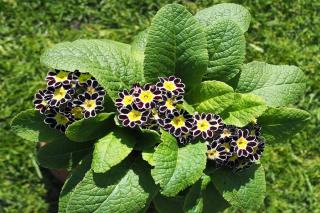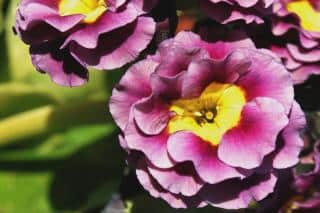

Primula auricula is a small perennial that is easy to identify and simple to grow. Its light-colored foliage and original flowers will definitely find their spot in flower beds and along edges in your garden.
Botanical name – Primula auricula
Common names – auricula, bear’s ear, cowslip, auricula primrose
Family – Primulaceae
Type – Perennial
Height – 6 to 10 inches (15 to 25 cm)
Planting density – 20 to 25 plants per sq. yard (m²)
Exposure – sun to part shade
Soil – humus-rich, well drained, neutral to alkaline pH
Hardiness – hardy
Flowering – Spring
Foliage – evergreen
In the “auricula” group within the primrose family, you’ll find 3 main sub-groups: moutain or alpine auricula, showroom auricula, and garden or flower bed auricula.
Primula auricula is in this last “garden flower” category. Some of its characteristics are that it is hardy and resilient, and pretty easy to grow when the environment suits it well enough.

The foliage is oval-shaped, and the color ranges from pale green to gray-green. Leaves seem coated with a powdery substance called farina. This is actually part of the plant itself, and it isn’t a disease (even though it looks similar to powdery mildew).
For your auricula to be simple to care for later on, it helps to prepare growing environment to help the plant reveal its full potential:

When you’ve chosen the perfect spot for it, simply follow these few steps:

You’ll only have to trim it to eliminate wilted flowers and damaged or dead leaves. Increase the thickness of your mulch every year to compensate for the fact that it slowly breaks down.
Bear’s ear propagation only needs a few steps: divide the clump or dig out a few offshoots that pop out at the foot of the stem.
Whichever technique you prefer, make sure you do this in Autumn to help the fledgling new plants grow strong root systems over Winter.
The single most common disease to affect Primula auricula is gray mold (botrytis).
As for parasites and pests, keep a lookout for small aphid colonies, slugs and red spiders.
Auricula primrose is perfect to line edges of flower beds, up front as a first line of color. Pair it together with Aubrieta, navelwort, Saxifraga arendsii, or, why not, one or two specimens of bishop’s hat.
There’s great fun to be had with the foliage, too, pairing the leafage of Primula auricula together with that of contrasting darker-leaved plants such as Ophiopogon planiscapsus ‘Nigrescens’ for instance.
Many varieties are extremely hardy, these make for excellent choices for potted compositions that you can’t winterize very well because they’re too large or in a showy place.